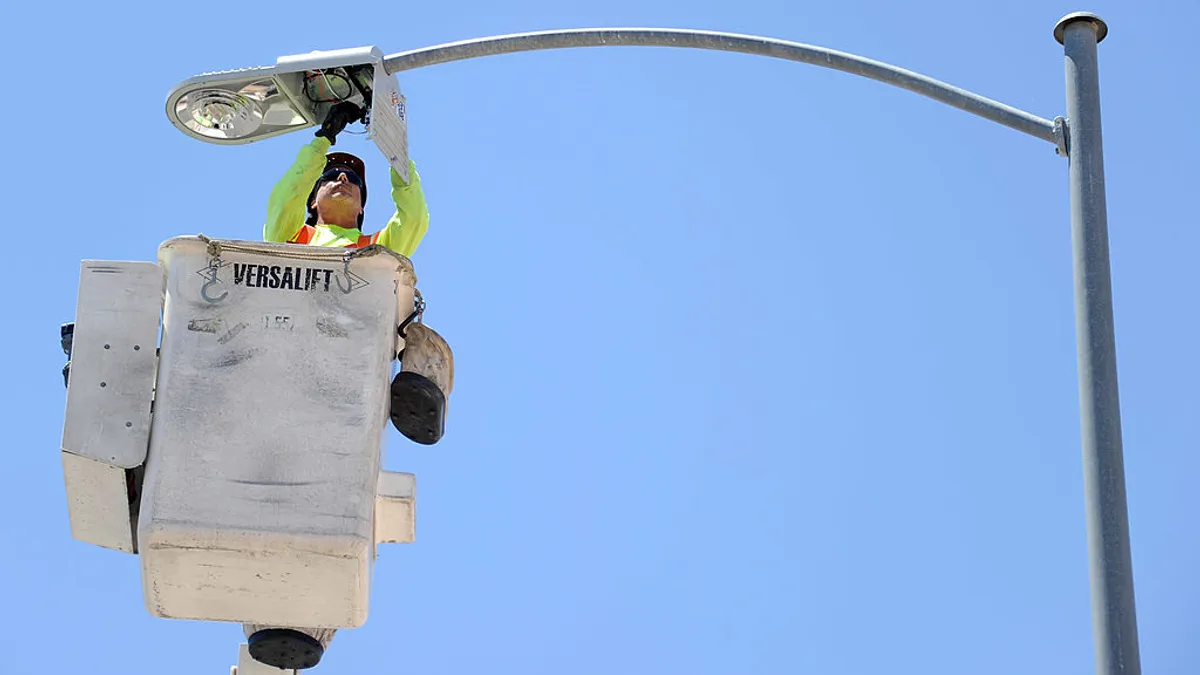Dive Brief:
- An $8.4 million energy-efficiency project in Fullerton, California, will save the Orange County city $12.1 million, it says, and it plans to use some of those savings to fund smart-city technologies.
- The city plans to upgrade about 7,700 lighting fixtures with new LED technology to reduce energy consumption, increase the fixtures' lifespans by a minimum of 20 years and prepare for additional functionality in the future. Energy service provider NORESCO will also work with the city and the local utility, Southern California Edison, to convert almost 600 pole lights to LED technology.
- Projects the savings will fund include 15 new dual-port integrated electric vehicle chargers throughout the city, a ground-mounted photovoltaic (PV) system at the main water plant that provides renewable energy and carport-mounted PV systems at its city hall and the police department.
Dive Insight:
Fullerton's self-funded project will help it prepare to convert more streetlights to LED technology, a move that also prepares them for other functions that have made streetlights the quintessential smart city technology. The effort will provide important data related to cost calculations and other factors that will help local leaders secure financing for future conversions, according to the announcement.
LED streetlights and streetlight-based smart-city sensors are expected to become a $28.1 billion market opportunity within this decade. Philadelphia recently launched a yearlong smart streetlight pilot to collect real-time information about traffic, street activity and the environment. Meanwhile, Chicago completed its smart streetlight program in early February, converting about 85% of its streetlights to LEDs. The conversion is projected to save the city $100 million in electricity costs over the next decade while also creating “one of the largest and most reliable smart technology infrastructure systems in the country,” according to the city.
Smart streetlights serve as the gateway into a lot of other smart city capabilities, said Michael Lake, president and CEO of Leading Cities, a global smart city non-profit. They have a strong business case, as the payback period is short and the impact is immediate, he said.
Similarly, Fullerton’s streetlights will serve as a backbone for local smart-city initiatives, according to Angela Vincoli, a senior marketing analyst at NORESCO. Almost 300 advanced lighting control units will be deployed, she said in an email interview.
“The units will provide innovative assistance through a cellular platform for city staff to reduce routine maintenance. An interoperability function will allow for remote control and tilt notification,” she said. The project will lay the groundwork for the city to add noise detection capabilities, air quality monitoring and 4G/5G cellular network capabilities to help address the digital divide, according to Vincoli.
The city began working with NORESCO in March 2021, and construction began in October 2021, with a 14-month planned construction cycle. The city will begin reaping the benefits of these technologies and improvements as they come online, Vincoli said.
The project is anticipated to reduce Fullerton's annual carbon dioxide emissions by about 2.8 million pounds, the equivalent of planting 1,306 trees, the city says. In addition, it will provide at least 50 local construction jobs and will include a “rigorous commissioning and measurement-based verification plan” to keep the energy savings on track.
The savings will also help the city replace essential heating, ventilation and air-conditioning systems at the end of their life cycles and make other energy-efficient updates to building systems. “The project demonstrates that energy savings can help local governments tackle deferred maintenance while also expanding smart city technologies and distributed energy resources,” the announcement says.
As it becomes increasingly common for cities to switch to LED lights over the next five or ten years, Lake said city leaders can anticipate that labor will likely be one of the biggest costs. Another common obstacle cities might face is that utility companies often own the actual streetlights — not the city — and utility companies don't necessarily have the incentive to make those investments, he said.
Lake also said he advises city leaders to go beyond the LED conversion. If cities are going to already pay for the cost of labor to convert streetlights to LEDs, he said they should consider installing LEDs that allow integration of additional sensors or other technology, especially since the cost of sensors has decreased so much.
Fullerton's project could be a model for other cities that are seeking ways to fund smart-city projects while also reducing energy consumption, according to Vincoli.
"Improvements that have faster financial paybacks, like lighting conversions to LEDs, can help fund technologies that are desirable but offer longer paybacks," she said. "That means leaders who aspire to even healthier, safer, more sustainable and more intelligent buildings, including [through the use of] smart city technologies, can help their local government get started on the path regardless of financial considerations."
















